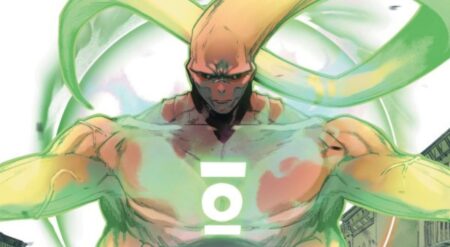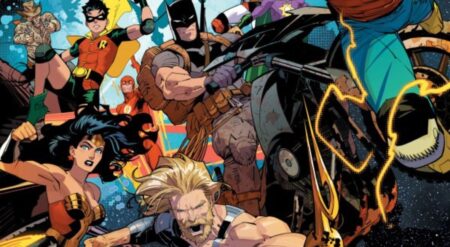
Wally West is being sent through time. A surge of energy pulled Wally into the Speed Force, propelling his consciousness into the body of various speedsters throughout history. In each of these eras is another surge, which he must prevent from exploding. In the present day, Mister Terrific, Green Arrow, and Barry Allen are trying to bring Wally home.
Within this issue, Wally finds himself in the body of the first Flash, Jay Garrick, during the middle of World War II. Teaming up with The Ray, another legendary hero of that time, Jay was sent on a mission to recover the Spear of Destiny. But the two soldiers are too late and find themselves in the clutches of the Nazis. With the powerful artifact in the hands of Adolf Hitler himself and the two heroes captured, Wally must use the old speedster’s body to escape and save history.
The plot is brimming with energy. There is a lot of content within this story and all of it is enjoyable. The concept of the arc is incredibly fun and allows for a totally different setup in each issue, with a new set of characters and brand new objectives. The Flash #770 has the absurd events that were often seen in the classic Flash comics during WWII itself. This implies that Adams is adapting the very atmosphere that was felt from the Silver Age, not just borrowing the plot. There is still the present-day adventure that has imprinted itself into the tale. The layout of the story may be formulaic but is still very exciting to read. There are incredible scenes of escape and combat, with a final page that suggests that Wally’s ordeals aren’t over.
Although Wally is the central character within The Flash #770, he isn’t the most powerful figure within the comic. That honour lies with Jay and The Ray. Both of these heroes are given a brilliant story arc within just a single issue. The readers know Jay. Wally and Barry know Jay. But they know him as an older speedster who is often in the background of stories. There is something hair-raising about seeing him in his prime, battling Nazis. He and Ray have the loud, brash attitude that came from characters from that period and the reader can’t help but find it incredibly likable.
The absurdity of the characters stokes the madness inside the issue. Adams could have had the wartime heroes battle generic Nazis or a nameless officer. But no. The Spear of Destiny is wielded by Hitler. The bizarreness of the situation will draw a grin from the reader on several occasions.
Wally himself struggles to get a foothold within this comic. So much of his dialogue is based around exposition as he and Jay vie for control within the one body that little is left for Wally’s personality. He is a born hero and slots into the mission at hand easily, but not much can be said for him finding a voice. This can be said about one of the other present-day characters as well because Green Arrow does nothing.
The art features many positive aspects, but some alterations may drastically improve it. Peterson is the artist for the WWII time period whilst Herbert draws the present-day scenes. Maguire illustrates the final page that leads into the next issue. There are splash pages and fight scenes that are terrific to read, the choreography perfect in that regard. The static jumps off the page when Wally first enters Jay’s body, capturing the shock pasted on the older man’s face by the younger man’s emotion beautifully. And the sense of speed is depicted expertly, important in a Flash comic. However, Peterson makes a peculiar decision to obscure or hide Garrick’s face in panels where doing so looks odd. It makes sense when Wally arrives, as the implication is that it’s a mystery who is in control of Jay’s body. But the frequency of this happening is strange and detracts from a plethora of facial expressions that would provide excellent storytelling.
In a similar vein, there are places where the shadows appear to fall awkwardly and end up restrictive and uncomfortable to see. This is only when it’s really dark, but it is noticeable when it happens. Additionally, Peterson’s musculature that he grants the heroic characters are nice at a first glance. But there are just a few instances where the perspective and proportions don’t fit the style around the rest of the page, off-putting slightly. Maguire’s art style is similar to Peterson’s, but the proportions are righted.
The colours are brilliant for making your characters stand out in a gloomy atmosphere. For example, the gorgeous red and gold of Jay’s shirt, with the glint on his winged helmet shining in the dim light. The Ray’s brightness glows beautifully when the heroes are placed in dark grey environments. The letters are very easy to read with slightly thicker line weights in the words themselves making them bold and powerful.
The Flash #770 is a comic pulsating with adventure. The story is pure fun and very easy to pick and read from any chapter of the current arc. The setting and use of characters in this issue led to exciting circumstances. But Wally’s strength as a character needs to return instead of solely being a mouthpiece for exposition. The artists are all talented creators despite the criticism but the book should be picked up if you just need a chaotic time travel story, or are a Flash fan.
The Flash #770 is available where comics are sold.
The Flash #770
TL;DR
The Flash #770 is a comic pulsating with adventure. The story is pure fun and very easy to pick and read from any chapter of the current arc. The setting and use of characters in this issue led to exciting circumstances. But Wally’s strength as a character needs to return instead of solely being a mouthpiece for exposition. The artists are all talented creators despite the criticism but the book should be picked up if you just need a chaotic time travel story, or are a Flash fan.






